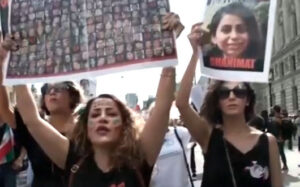Special to WorldTribune.com
 By John J. Metzler, March 13, 2024
By John J. Metzler, March 13, 2024
Iran’s regime has been firmly condemned by a UN fact-finding mission investigating the unprovoked killing of Masha Amina two years ago, in a incident which set off nationwide protests.
Mahsa Amini, a 22-year-old student, according to a UN fact-finding mission, died in police custody after violating the Islamic Republic’s strict “morality rules” requiring women to wear the headscarf.
Amini’s death triggered widespread pro-democracy demonstrations which rocked Iran for months. The crackdown by Islamic Republic militia and security forces killed more than 500 civilians and injured thousands more, some very critically. The UN mission cited “disproportionate use of lethal force,” by the regime.
Mandated by the Human Rights Council, the UN Fact Finding Mission clearly cites, “Pervasive and deep-rooted structural and institutionalized discrimination against women and girls, permeating all areas of their public and private lives, was both a trigger and an enabler of the widespread serious human rights violations and crimes under international law committed against women and girls in the Islamic Republic of Iran.”

The report adds, “High-level State authorities encouraged, sanctioned and endorsed violations of human rights through statements justifying the acts and conduct of the security forces; engaged in a disinformation campaign depicting protesters as ‘terrorists’ or ‘separatist’ groups.”
Still for months massive demonstrations of women rocked Iran bringing huge international sympathy and solidarity in world capitals from Paris to London, and Berlin to New York. While the world rallied to the cause of the long-suffering Iranian women, the regime eventually quelled protests. The demonstrators’ slogan “Women, Life, Freedom” became a global clarion call.
The UN fact finding mission said the security forces used shotguns and submachine guns against demonstrators, “thereby committing unlawful and extrajudicial killings.” It particularly noted that protesters were often deliberately shot in the eyes as to handicap them.
Moreover regime security and the quaintly titled “morality police” regularly used sexual intimidation, rape and humiliation against women who were seen as flouting Islamic rules.
“These acts form part of a widespread and systematic attack directed against the civilian population in Iran, namely against women, girls, boys and men who have demanded freedom, equality, dignity and accountability,” stressed Sara Hossain, chair of the UN inquiry, urging the Iranian authorities to “halt the repression.”
The killing of Masha Amini, an ethnic Kurd, for not wearing the obligatory headscarf (Hijab) further radicalized Iran’s youth who are increasingly frustrated and fed up with mantra of religious regulations promulgated but equally enforced by the ruling Islamic Republic. The massive women’s pro-democracy demonstrations which followed Amini’s death, ignited a long smoldering frustration with the theocratic regime in Teheran.
|
In Teheran, only 1.8 million of the 7.7 million eligible voters, 24 percent, cast their ballots according to official figures. Significantly nearly 400,000 invalid ballots, many blank, were cast, a sign of voter frustration. |
Now the long simmering revolt has reached another stage; nationwide Parliamentary elections for the Islamic Republic were overwhelmingly boycotted by voters, especially the young. Iran’s Interior Minister said 25 million of 61 million eligible voters cast ballots in the elections for the parliament and the Assembly of Experts, which chooses Iran’s supreme leader. The regime claimed a 41% turnout, the lowest since the 1979 Islamic Revolution toppled the pro-Western reformist Shah.
Interestingly former reformist president, Mohammad Khatami, (1997-2005) chose not to vote, having warned that Iran was “very far from free and competitive elections.”
Voter apathy was particularly evident in the capital, Teheran, which holds the most seats in the 290-seat parliament. In Teheran, only 1.8 million of the 7.7 million eligible voters, 24 percent, cast their ballots according to official figures. Significantly nearly 400,000 invalid ballots, many blank, were cast, a sign of voter frustration. About 40 moderates won seats in the new parliament, yet the legislature remains overwhelmingly dominated by hard-liners.
Younger people are “tuned out” to the appeals and demands of the Teheran authorities whom they see as distant and socially discriminatory. Even though the wearing of the Hijab is mandated for women, a recent conversation with a young Iranian from a provincial city outside Tehran told this writer that “almost all young women” are flaunting the rules and not wearing the headscarf. Yet he cites deep desperation and disillusion inside Iran where corruption runs rife, and the future seems bleak even for an educated population. This 30 something fellow sees an internal collapse within five years.
The clock is ticking for the Islamic Republic of Iran, the authoritarian theocratic regime which has ruled this once respected land for 45 years. Iranians will soon celebrate the Nowruz, the Persian New Year on the first day of Spring. It symbolizes the triumph of Light over Darkness. Hopefully it’s a fitting metaphor for Iran’s future.
John J. Metzler is a United Nations correspondent covering diplomatic and defense issues. He is the author of Divided Dynamism the Diplomacy of Separated Nations: Germany, Korea, China (2014). [See pre-2011 Archives]
